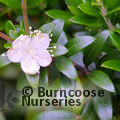MYRTUS communis subsp. tarentina

<







>
MYRTUS communis subsp. tarentina
Commonly known as Tarentum myrtle

A compact rounded bush with needle-like leaves and creamy-white scented flower
Full Plant Details - Sun/Soil & other attributes
-
Floweringlocal_floristJanlocal_floristFeblocal_floristMarlocal_floristAprlocal_floristMaylocal_floristJunlocal_floristJullocal_floristAuglocal_floristSeplocal_floristOctlocal_floristNovlocal_floristDec
-
BerriesThese plants have berries.
-
 Good to know
Wildlife plant - insects.
Good to know
Wildlife plant - insects. -
 Pests & Diseases
Trouble free
Pests & Diseases
Trouble free -
 Place of origin
Garden origin.
Place of origin
Garden origin. -
Resistant to honey fungusThese plants have little or few problems with honey fungus.
-
EvergreenNarrowly elliptic leaves to 2cm (¾in) long.
-
 White
White
-
BorderSuitable for a shrub border
-
Frost hardy (down to -5)
-
 Entire
Entire
-
 Elliptic
Elliptic
-
 Height
1.5m (5ft)
Height
1.5m (5ft) -
 Spread
1.5m (5ft)
Spread
1.5m (5ft) -
Medium shrubTypically grow to around 4-6 feet in heightFlowers are sometimes pink-tinged, followed by white berries.
-
 Pruning group 6
Suitable for: Evergreen shrubs or climbers that need little to no pruning.
Pruning group 6
Suitable for: Evergreen shrubs or climbers that need little to no pruning.
Action: Trim back shoots that spoil symmetry and to fit available space.
When: Annually after flowering if on previous year's growth, or in later Winter or Spring if flowering on current year's growth, or as requires.
-
 Half hardy - unheated greenhouse / mild winter
Hardy in coastal and relatively mild parts of the UK except in severe winters and a risk from sudden (early) frosts. May be hardy elsewhere with wall shelter or good micro-climate. Likely to be damaged or killed in cold winters. Plant can withstand temperatures down to -5°C (23°F)
Half hardy - unheated greenhouse / mild winter
Hardy in coastal and relatively mild parts of the UK except in severe winters and a risk from sudden (early) frosts. May be hardy elsewhere with wall shelter or good micro-climate. Likely to be damaged or killed in cold winters. Plant can withstand temperatures down to -5°C (23°F) -
Scented foliage
-
Autumn Seasonal Interest
-
Summer Seasonal Interest
-
Fertile moist well-drained soil
-
 Full sun
Shelter from cold, drying wind
Full sun
Shelter from cold, drying wind -
Mature Size1.5m (5ft)


1.5m (5ft)
View Planting Tips and Care Advice
Myrtus - Growing Guide









